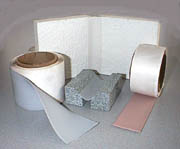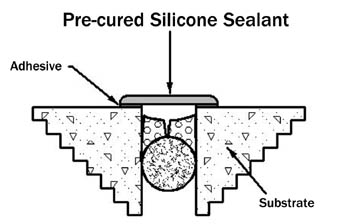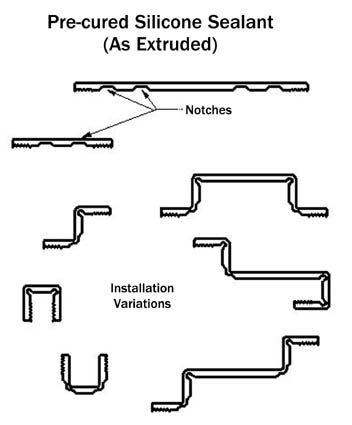
Pre-cured joint sealants are produced by extruding sealant material and allowing it to cure to a rubbery, elastomeric product in a controlled manufacturing environment. Pre-cured joint sealants are packaged in cured form, often in rolls, instead of typical liquid form packaging (tubes, pails, etc.). Pre-cured joint sealants are installed using a thin layer of wet sealant on each side as the adhesive to attach the material to the substrate being sealed. With the outer edges adhered to the substrate, the middle of the pre-cured sealant, which is not bonded to the substrate, acts as the area for expansion and contraction.

New over old
Several types of pre-cured joint sealants have been used in the industry over the years, ranging from polyurethane and polysulfide to silicone. Each type offers unique chemical and physical characteristics. Silicone pre-cured joint sealants have been most commonly used in construction applications for several reasons.First, because of their molecular structure and high bond energy, silicones have excellent aging characteristics and are more resistant to ultra-violet light and weathering than organic materials such as polyurethanes, giving silicone a much longer effective lifespan than these organic materials. Because silicones do not degrade when exposed to the elements, it is possible for manufacturers to produce the material very thin (1 to 2 mm). Thin pre-cured joint sealant minimizes expansion and contraction forces on the substrate and creates the pleasing appearance of a flat profile.
Additionally, the movement capability for silicone pre-cured joint sealant can be as high as +200 percent/-75 percent, significantly higher than any wet sealant. This combination of high movement capability and thin material allows pre-cured silicone sealant to easily handle multi-directional movement. Additional advantages include a wide operational temperature range and better resistance to color fading. For these reasons, silicone is the preferred pre-cured sealant material used in the construction industry today.
Over the past two decades, pre-cured silicone sealants have been used in construction mainly for renovation applications. One example of a typical application for pre-cured silicone sealant is repair of failed (standard) sealant joints.
When pre-cured silicone sealant is used to repair a failed traditional sealant joint, there is no need to remove the old sealant. Installation is easy; the pre-cured sealant is simply applied over the old joint using a thin layer of silicone adhesive on each side of the pre-cured sealant. The pre-cured sealant is then simply pressed into place to ensure intimate contact between it and the adhesive as well as between the adhesive and the substrate. Once it has been pressed into place, any excess adhesive is removed and the installation is complete.
Two of the most important advantages of using pre-cured silicone sealant are a decrease in time required to complete a project and a reduction in overall project cost. Labor costs will be lower since several labor-intensive steps are removed from the process when pre-cured silicone sealants are used. For example, the old sealant does not need to be removed when using pre-cured silicone sealant. Additionally, the substrate does not need to be abraded to ensure the complete removal of the old sealant. Also, pre-cured sealants do not need to be tooled after installation. Each of these factors can help reduce project cost when using pre-cured silicone sealant.
This system for repairing failed sealant joints is especially useful with soft substrates such as EIFS. With EIFS, removal of the old sealant will damage the substrate and ruin the integrity of the joint. Because of this, many EIFS manufacturers recommend the use of pre-cured silicone sealant when repairing EIFS sealant joints. Several pre-cured silicone sealant manufacturers have the ability to produce textured material to match an EIF system, giving the repaired joint a better appearance.

A bridge too far
Pre-cured silicone sealants are also used in applications where wet-applied sealant bridge joints have been utilized in the past. These bridge joints have been used in butt joint applications where the joint depth does not meet the minimum 1/4 inch for bonding to the substrate. This is commonly found in applications such as leaky aluminum window systems. These wet-applied sealant bridge joints are difficult to install and nearly impossible to achieve a consistent and uniform joint. Additionally, since the industry standard thickness for a wet sealant bridge joint is 6 mm and pre-cured silicone sealant is typically produced at a thickness of 2 mm, the pre-cured silicone sealant is more aesthetically pleasing.Due to the thin adhesive layer required with the pre-cured sealant system, the adhesive cures rapidly and joint deformation during cure is virtually eliminated. This is evident when comparing the cure time of a few hours for the adhesive used with the pre-cured silicone sealant to a 6 mm thick wet sealant bridge joint, which can take several weeks to cure completely. Indeed, this prolonged cure time frequently causes many wet sealant joints to develop ripples or folds as the joint expands and contracts before the wet sealant reaches complete cure.
In addition to an unpleasant aesthetic appearance, this situation damages the integrity of the joint. These factors, combined with ease of application, are causing pre-cured silicone sealant to replace wet-applied sealant in many bridge joint applications.
Another situation where pre-cured silicone sealants are used instead of wet sealants is one in which the width of the joint is not sufficient to handle the movement it experiences. This occurs frequently in buildings that are lacking an adequate number of expansion joints on the exterior substrate, causing the joints to expand and contract beyond the movement capability of any wet sealant.
In this case, pre-cured silicone joint sealant works very well because the material can handle the extreme movement in these types of joints. Another example of this phenomenon is in windows where the opening does not leave adequate space for a working perimeter sealant joint. Because the sealant adhesive is only used on the edges of the material, the pre-cured silicone sealant system creates its own artificial joint width to handle the movement. This allows the pre-cured silicone sealant to effectively seal this and similar applications.
Aluminum window systems are an application where pre-cured silicone sealants have been used to repair many major water intrusion problems. Because most aluminum window systems contain numerous metal-to-metal joints and other potential areas for leaks, when these systems fail it can be very difficult to seal these leaks with traditional wet sealant. Pre-cured silicone sealant can be applied over the leaking areas in these systems and when using a color-matched material, the pre-cured sealant may not be noticeable at all.
Pre-cured silicone sealants are readily available in many standard sizes and colors. Manufacturers also offer custom color and custom design material to fit many different application requirements, including the textured material previously discussed. Besides the applications already discussed, pre-cured silicone sealants are used successfully in many other applications including:
• Curtainwall seals
• Skylights
• Roofing and parapet seals
• RV, marine and transportation seals
• HVAC system seals
• Seals for showers and tubs
Custom design materials can be produced with one or more notches in the extrusion. These notches allow the pre-cured silicone sealant to follow complex bends on a building in applications such as inside and outside corners, parapet caps and window mullions. Figure 6 shows some installation variations of the notched material. With myriad of custom options available with pre-cured silicone sealant, virtually any waterproofing application problem can be solved using these products.
Finally, the use of pre-cured silicone sealant can result in a more energy efficient building. The majority of buildings have numerous leaks throughout the structure, most of which are in the joint areas. Because of these leaks, buildings need to be pressurized, resulting in higher heating and cooling costs throughout the year. Virtually any leak area in a building can be sealed using pre-cured silicone sealant. Once these leaks are sealed, the amount of air required to keep a building pressurized is drastically reduced. This results in lower heating and cooling costs, making the building much more energy efficient.
As leaders in the construction industry begin to realize the impact that cost savings and product performance can make in a variety of applications, it is expected that the market share for pre-cured silicone sealants will continue to grow. The scope and magnitude of the use of these materials in the construction industry will greatly depend upon collaboration between contractors, architects, engineers, consultants and manufacturers.



